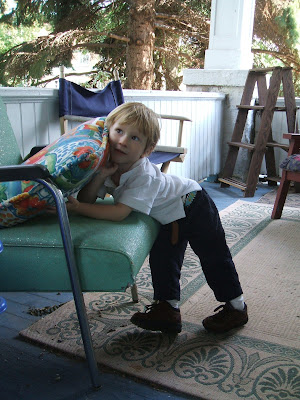
This is a brush calligraphy set given to me by my dear chum Emily once upon a time. She brought it back with her from China. Thank you, Emily. It is really a wonderful little thing. Inside this lovely, silk-covered box, is a complete set for brush and ink work.
Gibbie is learning to do it too. His first job is to take each component out of the box, and set them up around his pad of paper. I fill the tiny water bowl with water. He uses the delicate spoon to move the water into the stone basin where it will be made into ink. Then we take the stick of compressed pigment, and grind it on the stone until we have a good amount of nice, black ink.
 There is a special porcelain stand upon which to rest the brushes, and places in the case for each brush. One brush has been designated as Gibbie's. I've noticed the most difficult thing for small children in painting is not destroying brushes. He's working hard on this, but still, just in case... I love this painting set because it is self contained (here we are using it at a local coffee shop) and very high quality, and getting to take out all the parts and mix the ink ourselves is an enjoyable part of the process rather than a chore.
There is a special porcelain stand upon which to rest the brushes, and places in the case for each brush. One brush has been designated as Gibbie's. I've noticed the most difficult thing for small children in painting is not destroying brushes. He's working hard on this, but still, just in case... I love this painting set because it is self contained (here we are using it at a local coffee shop) and very high quality, and getting to take out all the parts and mix the ink ourselves is an enjoyable part of the process rather than a chore.I learned a lot more about Chinese calligraphy, and painting when I studied it in college. Enough to feel almost unworthy of taking a brush in my hand!
Oh, and the best part is the little chop, the stone carved stamp with which the artist marks her work. Emily tells me that mine is carved with the phonetic syllables of my name. Pressing the chop into the greasy red inkpot and making that clear, bright red square on his white paper is the best part.


























